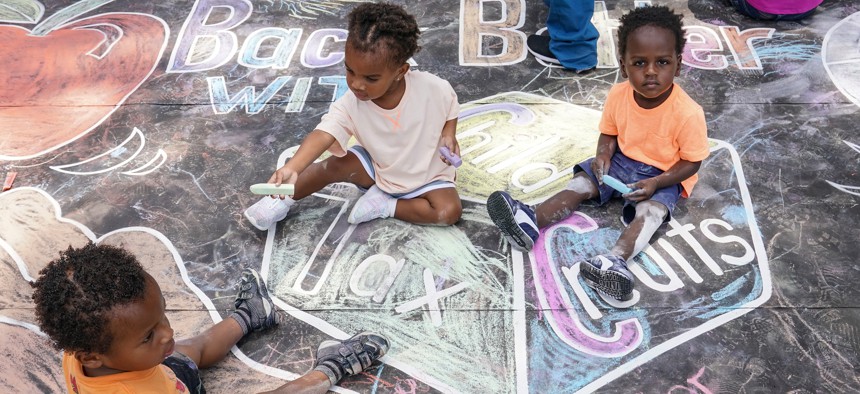Researchers Identify Ways to Replicate Success of Expanded Child Tax Credit

Children from the KU Kids Deanwood Childcare Center complete a mural celebrating the launch of the Child Tax Credit on July 14, 2021 at the KU Kids Deanwood Childcare Center in Washington, DC. Jemal Countess/Getty Images for Community Change
Working through community organizations that locals trust is the most effective way to increase the use of programs meant to lift people out of poverty, a study finds.
Many experts cite the 2021 expanded child tax credit as a major factor in slashing childhood poverty in half. While the enhanced version of the credit expired, a recent report highlights lessons learned from its rollout and the strategies communities can use to encourage greater use of similar credits to lift people out of poverty.
When Congress approved the expanded child tax credit, many families were newly eligible for the benefit. That also meant many families would need help understanding the credit, their eligibility and the application process.
To increase awareness and understanding of the initiative, Share Our Strength, a national organization aiming to reduce hunger and poverty, distributed grants to community-based organizations and IRS-sponsored volunteer income ax assistance, or VITA, sites to conduct outreach and assist clients with filing their taxes in 13 states.
The campaigns reached an estimated 3.3 million people and helped clients file 12,000 tax returns, claiming over $17 million, according to a recent report from the Urban Institute. Building trust and making information accessible to marginalized populations—including households of color, people who speak little English and low-income families—were key to that success, the report notes.
The Urban Institute worked with the program's grantees to document the strategies they used to reach and educate people who otherwise may not have applied for the child tax credit. Researchers studied which approaches could improve enrollment in other tax benefits—like the earned income tax credit—and found that trust and accessibility to assistance were critical.
Typically, VITA sites are active only during tax season, from late January through mid-April. By funding the sites year-round, people were able to seek help if they missed the filing deadline or ran into other complications.
Grantees also used a variety of other strategies to improve accessibility to information, like creating mobile assistance centers that could travel to residential neighborhoods, partnering with local food banks and expanding hours of service. Some used the funding to remove other barriers by offering child care at events or providing transportation.
Regardless of how the organizations chose to connect with community members, all found it was essential to work with trusted local organizations. Training the groups about the child tax credit was essential for reaching families eligible for the credit.
Similarly, being intentional about who presented the information at outreach events also proved to be an important factor. Presenters who resembled their audiences tended to see more engagement, the report notes.
“They [the community members] felt like it was their peer versus someone showing up in town,” one aid worker is quoted as saying in the report.
In the age of social media, it can be easy to forget how powerful word of mouth is. But many organizations found that encouraging community members to share what they’d learned about the credit, and the availability of help, to be an effective strategy in increasing enrollment. In Louisiana, one aid worker said that word of mouth proved to be the most effective form of outreach they used.
Building trust is important beyond outreach efforts. Grantees found that many clients were skeptical of VITA sites to prepare their taxes because of the program's affiliation with the IRS. Some grantees found it challenging to convince clients that free, government-provided assistance is just as good—or better—than that provided by paid preparers.
“We try to find language that shows them that VITA sites are good, so phrases like ‘no cost to you,’” help, said one worker interviewed for the study. “In Texas, there is no regulation of paid preparers, so we’re trying to get people to understand that VITA volunteers are verified.”
An enhanced credit is most effective when paired with diligent outreach and education efforts, the Urban Institute report concluded. People need to know the credit exists, understand their eligibility and feel comfortable interacting with the agency administering the credit.
Molly Bolan is the assistant editor for Route Fifty.
NEXT STORY: As Americans Kick the Smoking and Drinking Habit, Sin Tax Revenue Drops






